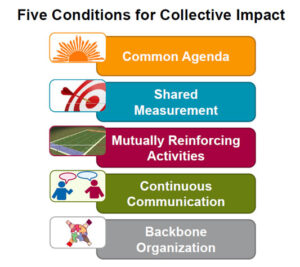Rational for a Call to Action!
Based on early forecasts by nonprofit and philanthropy experts… operating in a Post-Covid world will require organizations to transform the way they conduct business or risk extinction based on the following:
- Conservative estimates are that 10 – 20% of all 1.7 million nonprofits nationwide will become dormant or permanently close their doors by the end of 2020.
- Most agree that federal stop-gap programs such as PPP loans only postpone the inevitable staff furloughs and layoffs across all types of nonprofits.
- Charitable giving by high net-worth individuals, in the short-term, will likely decline by up to 50% as they wait for their investment portfolios to stabilize.
- Giving patterns of middle-class families may slow to a trickle as they recalibrate spending priorities away from charitable giving.
- Most corporate and foundation giving will shift significantly towards health and human services nonprofits with cultural and environmental organizations feeling the greatest cut backs.
- Grant funding will dry up quickly with long-term, multi-year grants disappearing all together.
Those nonprofit organizations most likely to maintain a share of a shrinking pie will need to capitalize on several critical themes:
- Present clear outcome data that validates your relevancy and the impact you make
- Show a sustainable business model with a compelling value proposition
- Diversify income across multiple revenue streams
- Develop innovative strategies to attract new capital investments
- Aggressively pursue new partnerships, collaborations and mergers
Since the economy is in free-fall and the social malaise has not been this great in decades, many believe this new era of social distancing will likely result in long-term, permanent changes in most all aspects of life in America. Nonprofits must also evolve quickly or risk extinction!
As one CEO of a large community foundation stated…
“The pandemic is like a forest fire in the nonprofit sector, many organizations will be lost yet at the same time, it will present grand opportunities for new growth!”
Post-Mortem in a Post-Covid World
This process of moving beyond survival to a new level of sustainability should start with some genuine “soul-searching” with regard to your organization’s existence… its reason for being. Consider hosting a virtual planning meeting with all Staff and Board to explore (with an open mind) the following Sustainability “Formula” and to review each component and answer the questions below:

Planning considerations for the Board & Staff to discuss:
- Is our mission still important? Is our nonprofit still making a difference?
- Do we need to find new partners? Should we collaborate or merge?
- How has the pandemic diminished our donors’ capacity to invest?
- How trusted are we in the community?
Next, in keeping with the need to ensure sustainability, by collaborating, your organization might consider adopting the Collective Impact* Model as the structure for a community-wide, transformation initiative comprised of the public, private, and nonprofit sectors. This initiative might be lead by your organization as you take the position of the “Backbone” Organization as described in the Collective Impact Model!”
Your goal is to bring together Executive Directors, Presidents, CEOs, Boards of Directors, elected and appointed Government officials to be “signatories” to the first of its kind collaboration. The goal would be for these “signatory” entities to commit time and resources to fulfill these five conditions of the Collective Impact Model:
- A Common Agenda
- Shared Measurement System
- Mutually Reinforcing Activities
- Continuous Communication
- Backbone Support Organization
 *(CI) is the commitment of a group of organizations from the public, private and nonprofit sectors to a common agenda for solving specific community problems, using a structured form of collaboration. CI was first articulated in the Stanford Social Innovation Review. CI hinges on the idea that in order for organizations to create lasting solutions to community problems on a large-scale, they need to coordinate their efforts and work together around a clearly defined goal. The approach of CI is placed in contrast to “isolated impact,” where organizations work alone to solve social problems.
*(CI) is the commitment of a group of organizations from the public, private and nonprofit sectors to a common agenda for solving specific community problems, using a structured form of collaboration. CI was first articulated in the Stanford Social Innovation Review. CI hinges on the idea that in order for organizations to create lasting solutions to community problems on a large-scale, they need to coordinate their efforts and work together around a clearly defined goal. The approach of CI is placed in contrast to “isolated impact,” where organizations work alone to solve social problems.

